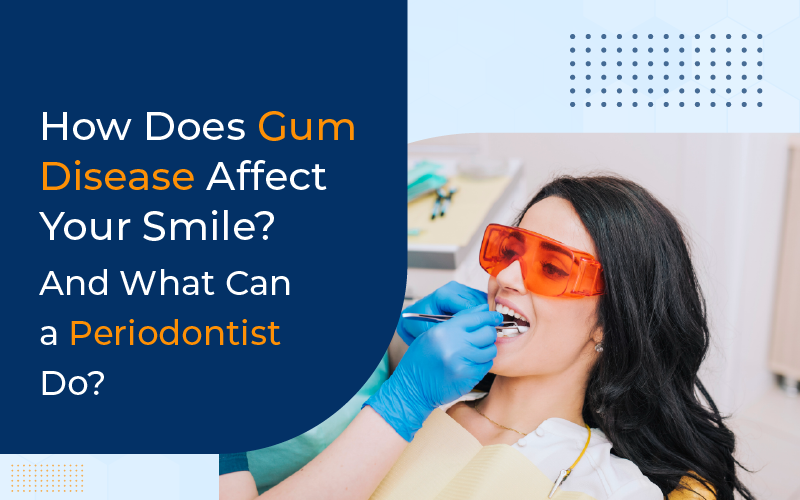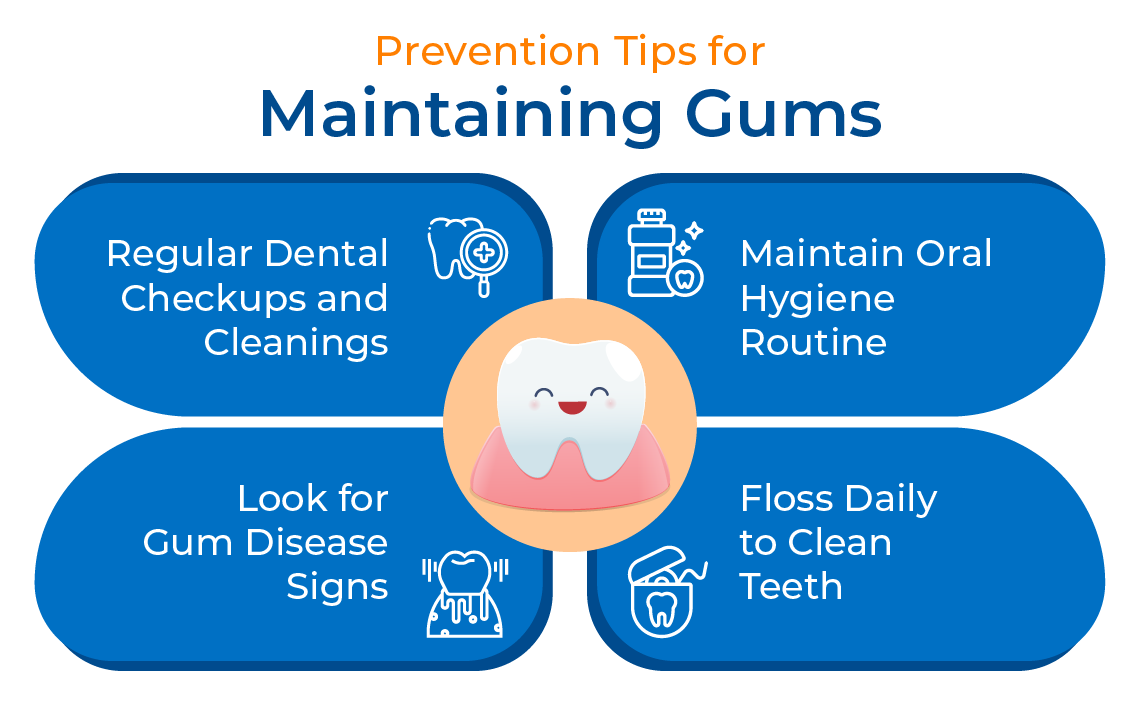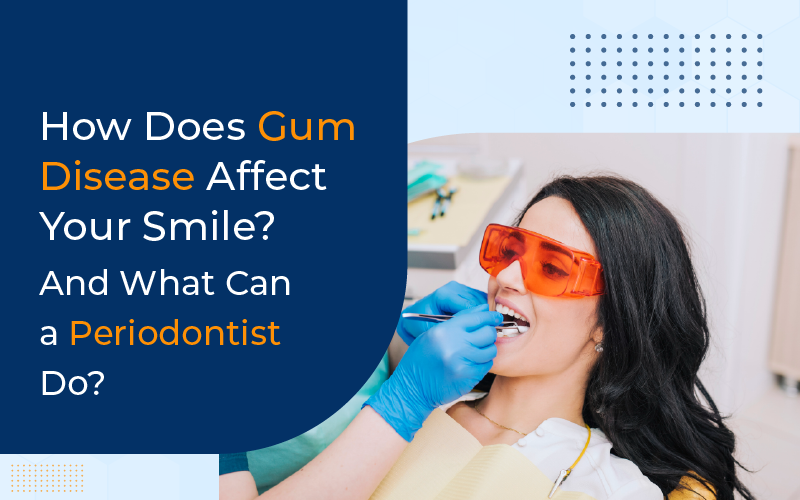
Smile is one of the most valuable assets, and taking care of your smile involves more than just flossing and brushing.
Gum (periodontal) disease is a common oral health condition that leads to dental health issues. However many people don’t realize that untreated gum disease might change the appearance of your smile.
In this blog, we will review what gum disease is, its common symptoms to watch for, and what periodontists can do to prevent your health smile.
What is Gum Disease?
Gum disease is also known as periodontal disease. It is an infection that affects the tissues surrounding teeth, including your bones, gums, and ligaments. This disease can affect anyone with poor oral hygiene such as people who don’t brush and floss regularly.
It starts with the accumulation of plaque which is a sticky film of bacteria on teeth. Moreover, if not removed through regular flossing and brushing, this plaque can harden into tartar, which leads to the development of gum disease.
Mainly there are two types of gum disease which are gingivitis and periodontitis. Gingivitis is the milder form where gums become red, swollen, and may bleed easily. This is often caused by poor brushing and flossing habits. If not treated properly gingivitis can advance to periodontitis.
In periodontitis, the gums are pulled away from the teeth and form spaces that can become infected. The body’s immune system fights the bacteria as the plaque spreads below the gum line, potentially leading to tooth loss if untreated.
Common Symptoms and Signs to Watch For
Some of the common symptoms and signs of gum disease to watch for
1. Swollen gums.
2. Tooth loss.
3. Bleeding gums.
4. Bad breath.
5. Pain while chewing.
6. Loose teeth.
7. Reddish gums.
8. Tender gums.
9. New space and gap between the teeth.
10. Infection around the gum line.
11. Gum recession.
Risk factors for periodontitis
– Hormonal changes– Some hormonal changes in women assigned female at birth, such as using birth control pills or pregnancy, can increase the chances of developing periodontitis.
– Diabetic patients- People who have diabetes have a greater risk of developing infections which also include periodontitis.
– Genetic factors- Your family history as well as genetics can put you at higher risk for this disease.
– Smoking- This is one of the most significant factors that weakens the body’s ability to fight this infection.
– Other health issues- Health issues that cause inflammation in the body like cardiovascular, COVID-19, and arthritis diseases are linked with gum disease.
Who is a Periodontist and What Do They Do?

A periodontist is a dentist who specializes in treating gum diseases and the structures around the teeth, making them an essential dentist for all your dental needs.
They help in preventing, diagnosing, and treating gum problems. Periodontitis treatment can help you to keep your gums healthy, which is important for having a good smile and keeping your teeth for a long time.
What periodontists do-
– Treat gum diseases like gingivitis and periodontitis.
– Periodontitis treatment helps in deep cleaning the mouth to remove plaque and tartar.
– Place dental implants to replace missing teeth.
– Perform surgeries to help heal gums.
– Use lasers and other modern tools for less painful periodontal disease treatments.
– Monitor the health of gums and bones around teeth.
Treatment Options for Gum Disease

People having moderate to advanced gum disease require surgical intervention, and these surgical treatments for this disease include-
Flap Surgery
One treatment for treating gum disease is flap surgery. It involves lifting the gums back to remove tartar buildup and smooth areas of damaged bone, allowing the gum tissue to heal more effectively around the teeth. Once the area is clean, the gums are sutured back into place to fit properly around the tooth.
| Purpose | Treats advanced gum disease. |
| Process | Gums are lifted, cleaned, and then reattached. |
| Outcome |
|
Gum Grafting
Gum grafting is a dental procedure for treating receding gums, which can expose the roots of the teeth, making them sensitive and prone to decay.
In this periodontal disease treatment, tissue from another part of the mouth is attached to the affected area to cover the exposed roots and help prevent further recession.
| Purpose | Covers exposed tooth roots. |
| Process | Tissue is taken from the palate and attached to the gum area. |
| Outcome |
|
Tissue Regeneration
Tissue regeneration in dentistry is used to regenerate bone and gum tissue that has been lost due to periodontal disease.
This procedure often involves placing a special biocompatible fabric between the existing bone and your tooth, which encourages your body’s natural ability to regenerate bone and tissue.
| Purpose | Regenerate lost bone and gum tissue. |
| Process | Uses biocompatible materials to encourage regeneration. |
| Outcome |
|
Bone Grafting
Bone grafting is a procedure to rebuild bone in the jaw that may have been lost due to periodontal disease, injury, or other reasons.
This treatment involves placing a material in areas where bone is missing, which serves as a platform for the growth of new bone.
| Purpose | Rebuilds lost jawbone. |
| Process | Placement of bone graft material. |
| Outcome |
|
Prevention Tips for Maintaining Gums

Here are some preventive tips for maintaining gums are listed below-
– “You should be vigilant for signs of gum disease, such as gum recession and bleeding gums, which might require Periodontal (gum) Surgery.
– You need to brush your teeth with the help of fluoride toothpaste twice a day.
– Visit the periodontist dentist in Simi Valley regularly for professional cleanings and regular checkups.
– If you floss daily then it will help you to remove food particles and plaque from between your teeth.
Conclusion
If you have symptoms of periodontal gum disease periodontal disease, then receiving gum disease treatment is an absolute solution for maintaining your healthy and beautiful smile.
If you suspect any signs or symptoms that are listed above, don’t hesitate to schedule an appointment with our Family Dental Care dentist in Simi Valley.
If you notice any of these symptoms, act now! Contact Family Dental Care today to preserve your smile.

